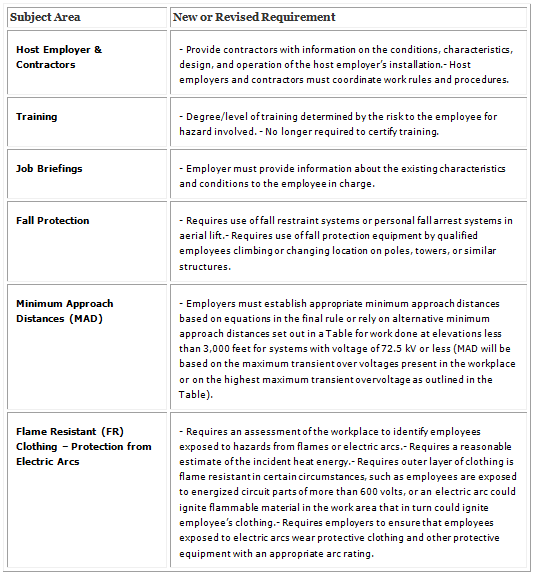Background
On June 15, 2005, OSHA proposed to update its existing standards on Electric Power Generation, Transmission, 29 C.F.R. § 1910.269 (Operations and Maintenance) and 29 C.F.R. Part 1926, Subpart V (Construction). OSHA’s primary objective in revising the two standards was to align and update the rules for the construction of transmission and distribution installations with the rules for operations and maintenance of electric power generation, transmission, and distribution lines and equipment.
On April 1, 2014, almost nine years after the proposed rule, OSHA released a copy of the final rules. The final rules will be officially published in the Federal Register on April 11, 2014 and most of the final rules provisions will become effective 90 days after the publication – July 11, 2014. OSHA has delayed the effective date of some provisions, such as requiring fall protection for qualified employees changing locations on poles and similar structures and application of the new requirements for minimum approach distances until April 1, 2015. However, for the most part employers must be prepared to fully implement the standard by July 10, 2014.
Highlights of Final Rule
Below are highlights of the final rules, which apply for both construction and general industry (operations and maintenance). In addition to these requirements, OSHA has revised provisions on deenergizing transmission and distribution lines to apply to multiple crews and to deenergizing network protectors. OSHA also revised provisions for operating mechanical equipment near overhead power lines to clarify that the exemption from maintaining the minimum approach distances only applies to the insulated portions of aerial lifts.
Within this rulemaking, OSHA also revised the general industry (§ 1910.137) and added a new construction (§ 1926.97) standard for electrical protective equipment. The existing construction standard for the design of electrical protective equipment applies only to electric power transmission and distribution work. OSHA has revised this requirement so that it now applies to all construction work where electrical protective equipment is used.

The major revisions include removing out dated consensus standards with more performance oriented requirements. However, the rule allows employers the option of compliance with the latest or future versions of consensus standards. The revisions focus on the design and manufacture of rubber insulating equipment, such as blankets, matting, covers, line hoses, gloves and sleeves and also includes new requirements for the design and manufacture of equipment and insulating barriers. Additionally, the revisions include care and use requirements, such as a requirement to visually inspect electrical protective equipment before use each day and testing on periodic basis.
Once the final rules are published in the Federal Register, any challenge to the final rules must be filed with a U.S. Court of Appeals within sixty days. Assuming the rules are published on April 11, 2014, industry members would have until June 9, 2014 to petition for review. It is too soon tell whether any such challenge will be filed. Impacted employers should begin to review the final rules and determine whether changes to work practices and procedures will be necessary to come into compliance with the new requirements.




 />i
/>i


